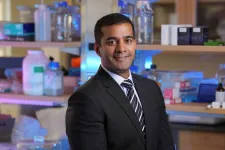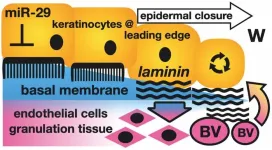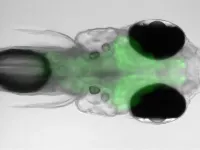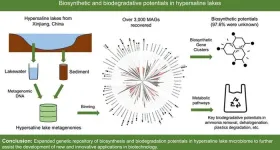(Press-News.org) INDIANAPOLIS—An Indiana University School of Medicine surgeon-scientist is leading a multi-institutional grant investigating the role of the sinus microbiome in chronic rhinosinusitis, an inflammatory disease that causes the lining of the sinuses to swell. The research team will study biospecimens from human sinus surgery patients in the lab and examine how bacteria in the microbiome shape the disease process and might offer novel therapeutic strategies.
Vijay Ramakrishnan, MD, professor of otolaryngology—head and neck surgery and a primary member of Stark Neurosciences Research Institute, has spent over a decade investigating the microbiome. The five-year, $2.9 million grant from the National Institute of Allergy and Infectious Diseases, part of the National Institutes of Health, is a first-of-its-kind grant studying the physiological effect of the sinus microbiome on chronic rhinosinusitis.
The microbiome is an accumulation of microorganisms—bacteria, fungi and viruses—that live within areas of the human body, such as the gut and sinus cavities. These microbes can shape a person’s health, predispose people to disease, act as disease modifiers and influence how people respond to specific treatments. In chronic rhinosinusitis, scientists believe microbes and bacteria play a role in sinus inflammation beyond a person’s traditional sinus infection.
“The upper airway is heavily colonized with bacteria, and the different types of influence immune processes and the general function of the surface lining,” Ramakrishnan said. “If we can steer the microbiome into a favorable healthy state, there are some functions that we can influence to maybe get us better treatment results.”
Ramakrishnan will work with researchers at the University of Colorado School of Medicine, led by Daniel Frank, PhD. Ramakrishnan started his research of the microbiome when he was a faculty member at the University of Colorado; he joined IU School of Medicine in January 2022.
Chronic rhinosinusitis affects nearly 10% of adults in the United States. Most patients manage the disease medically through sinus rinses, nasal spray medications and allergy treatments. It’s estimated, however, that 15% of chronic rhinosinusitis patients pursue sinus surgery, where most cases result in subpar outcomes, Ramakrishnan said. The volume of chronic rhinosinusitis cases, he added, is expected to rise due to climate change, pollution and western diet.
Antibiotics have long been prescribed for chronic rhinosinusitis—it’s one of the top conditions for antibiotic use, according to the Centers for Disease Control and Prevention—but they haven’t shown to be effective in treating most patients, Ramakrishnan said. The disease is now viewed as inflammatory rather than infectious, creating a need to develop new treatment strategies.
“This problem is very prevalent in adults. There’s only a handful of therapies, and they work about 75% of the time,” Ramakrishnan said. “Understanding the role of microbiome in this disease and focusing clinical approaches to restrict antibiotic use are our two main health outcomes.”
Researchers will collect biospecimens of surgical patients to investigate host-microbial processes in airway mucosal immunology. They’ll also use cell cultures to test how various microorganisms impact disease processes and initiate specific immune responses.
The grant also supports a longitudinal multi-institutional human intervention study of chronic rhinosinusitis surgical patients. The research team will investigate patient outcomes, medication use and how the microbiome of patients changes over time, Ramakrishnan said.
Ramakrishnan said this study moves beyond prior small observational studies by defining molecular, cellular, and immunological processes using a multi-omics approach, which incorporates data derived from transcriptomics and metabolomics.
The team will collaborate with Thomas O’Connell, PhD, associate professor of otolaryngology—head and neck surgery, to conduct tissue metabolomics and with IU network scientists at the Luddy School of Informatics, Computing, and Engineering at IU Bloomington to do a physics-based approach to understand networks of interaction between disease and patient outcomes and tissue-level multi-omics.
“We’re trying to figure out which chronic rhinosinusitis patients have a microbial component that we can influence, to steer them to better outcomes and allow their own bodies to restore health, thereby limiting antibiotic use and number of interventions,” Ramakrishnan said.
About IU School of Medicine
IU School of Medicine is the largest medical school in the U.S. and is annually ranked among the top medical schools in the nation by U.S. News & World Report. The school offers high-quality medical education, access to leading medical research and rich campus life in nine Indiana cities, including rural and urban locations consistently recognized for livability.
END
IU surgeon-scientist studying physiological effect of microorganisms in sinuses of chronic rhinosinusitis patients
2024-02-01
ELSE PRESS RELEASES FROM THIS DATE:
Stand Up to Cancer announces changes to scientific advisory committee
2024-02-01
LOS ANGELES – February 1, 2024 – Stand Up To Cancer® (SU2C) today announced changes to its Scientific Advisory Committee (SAC), which oversees SU2C’s scientific research.
Composed of cancer research leaders from academic, government, industry, and advocacy fields, SU2C’s SAC sets direction for research initiatives, reviews proposals for new grant awards, and conducts rigorous oversight of all active grants in the SU2C research portfolio in collaboration with SU2C’s president and CEO Julian Adams, Ph.D.
World renowned cancer researcher and Nobel laureate Phillip A. Sharp, Ph.D., who has chaired the SAC since SU2C launched in ...
Small RNAs take on the big task of helping skin wounds heal better and faster with minimal scarring
2024-02-01
Philadelphia, February 1, 2024 – New findings in The American Journal of Pathology, published by Elsevier, report that a class of small RNAs (microRNAs), microRNA-29, can restore normal skin structure rather than producing a wound closure by a connective tissue (scar). Any improvement of normal skin repair would benefit many patients affected by large-area or deep wounds prone to dysfunctional scarring.
Because the burden of non-healing wounds is so significant, it is sometimes called a “silent pandemic.” Worldwide, costs associated with wound care are expected to ...
Rural placements for medical students feed ‘pipeline’ for new family docs
2024-02-01
EDMONTON — New research shows an innovative education program is helping to address Alberta’s rural doctor shortage by making it more likely medical students will set up a rural family practice after graduation.
The University of Alberta was one of the first medical schools in Canada to set up its Rural Integrated Community Clerkship program back in 2007. It sends up to 25 third-year students for 10-month intensive work experiences with a single or small number of teaching physicians.
Instead of rotating to a new specialty placement every four to six weeks as in an urban ...
Zebrafish navigate to find their comfortable temperature
2024-02-01
All animals need to regulate their body temperature and cannot survive for long if it gets too high or too low. Warm-blooded organisms like humans have various ways to do this. They release heat by sweating or expanding the blood vessels in their skin, while shivering or burning fat in their brown adipose tissue has the opposite effect.
Cold-blooded animals such as the zebrafish, by contrast, cannot do any of these, so they have a different strategy. They look for places nearby that are at their “comfortable temperature,” just like how we might go out into the sun when we feel chilly or seek out some shade once it gets too ...
Buck scientists discover a potential way to repair synapses damaged in Alzheimer’s disease
2024-02-01
While newly approved drugs for Alzheimer’s show some promise for slowing the memory-robbing disease, the current treatments fall far short of being effective at regaining memory. What is needed are more treatment options targeted to restore memory, said Buck Assistant Professor Tara Tracy, PhD, the senior author of a study that proposes an alternate strategy for reversing the memory problems that accompany Alzheimer’s disease and related dementias.
Since most current research on potential treatments for Alzheimer’s focuses on reducing the toxic proteins, such as tau and amyloid beta, that accumulate in ...
Researchers identify critical pathway responsible for melanoma drug resistance
2024-02-01
(Boston)—One of the major challenges in cancer research and clinical care is understanding the molecular basis for therapeutic resistance as a major cause of long term treatment failures. In cases of melanoma, the main targeted therapeutic strategy is directed against the mitogen-activated protein kinase (MAPK) pathway. Unfortunately, in the vast majority of these patients, resistance to MAPK inhibitor therapies develops within one year of treatment.
In a new study from Boston University Chobanian & Avedisian School of Medicine, ...
Pandemic lockdowns and water quality: a revealing study on building usage
2024-02-01
During the COVID-19 pandemic, lower occupancy in buildings led to reduced water use, raising concerns about water quality due to stagnation. Government warnings highlighted increased risks of chemical and microbiological contamination in water systems. Studies showed that reduced usage and stagnation could elevate heavy metal levels and decrease disinfectant effectiveness, affecting microbial growth. To address this, regular fixture flushing was recommended, which temporarily improved water quality but also revealed the complexities of managing building water systems effectively.
In a recent study (https://doi.org/10.1016/j.ese.2023.100314) ...
Exploring the unseen: microbial wonders in earth's saltiest waters
2024-02-01
The study delves into hypersaline lakes in Xinjiang, China, exploring the genetic and metabolic diversity of microbial communities termed "microbial dark matters". Hypersaline lake ecosystems, characterized by extreme salinity, harbor unique microorganisms with largely unexplored biosynthesis and biodegradation capabilities. The research seeks to uncover novel biological compounds and pathways, potentially revolutionizing biotechnology, medicine, and environmental remediation by tapping into the untapped potential of these extremophiles.
A recent study (https://doi.org/10.1016/j.ese.2023.100359) published ...
As cancer therapies improve, more patients with rectal cancer forego surgery
2024-02-01
While surgery to remove rectal cancer can be necessary and lifesaving, it can sometimes come with significant drawbacks, like loss of bowel control. According to a study led by Wilmot Cancer Institute researchers, patients with rectal cancer who respond well to radiation and chemotherapy are increasingly foregoing surgery and opting for a watch-and-wait approach.
The study, published in JAMA Oncology, shows that the number of patients opting out of surgery rose nearly 10 percent between 2006 and 2020. These data reflect a shift toward what ...
Stanford Medicine-led study shows why women are at greater risk of autoimmune disease
2024-02-01
Somewhere between 24 and 50 million Americans have an autoimmune disease, a condition in which the immune system attacks our own tissues. As many as 4 out of 5 of those people are women.
Rheumatoid arthritis, multiple sclerosis and scleroderma are examples of autoimmune disorders marked by lopsided female-to-male ratios. The ratio for lupus is 9 to 1; for Sjogren’s syndrome, it’s 19 to 1.
Stanford Medicine scientists and their colleagues have traced this disparity to the most fundamental feature differentiating ...






